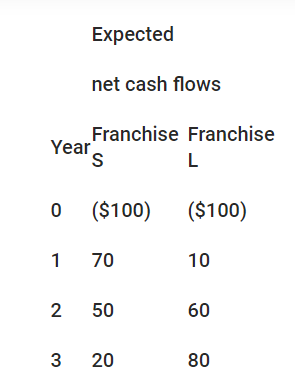You have just graduated from the MBA program of a large university, and one of your favorite courses was “Today’s Entrepreneurs.” In fact, you enjoyed it so much you have decided you want to “be your own boss.” While you were in the master’s program, your grandfather died and left you $1 million to do with as you please. You are not an inventor and you do not have a trade skill that you can market; however, you have decided that you would like to purchase at least one established franchise in the fast-foods area, maybe two (if profitable). The problem is that you have never been one to stay with any project for too long, so you figure that your time frame is three years. After three years you will sell off your investment and go on to something else.
You have narrowed your selection down to two choices;(1) Franchise L,Lisa’s Soups, Salads, & Stuff and (2) Franchise S,Sam’s Fabulous Fried Chicken. The net cash flows shown below include the price you would receive for selling the franchise in Year 3 and the forecast of how each franchise will do over the three-year period. Franchise L’s cash flows will start off slowly but will increase rather quickly as people become more health conscious, while Franchise S’s cash flows will start off high but will trail off as other chicken competitors enter the marketplace and as people become more health conscious and avoid fried foods. Franchise L serves breakfast and lunch, while Franchise S serves only dinner, so it is possible for you to invest in both franchises. You see these franchises as perfect complements to one another: You could attract both the lunch and dinner crowds and the health conscious and not so health conscious crowds without the franchises directly competing against one another.
Here are the net cash flows (in thousands of dollars):
Depreciation, salvage values, net working capital requirements, and tax effects are all included in these cash flows.
You also have made subjective risk assessments of each franchise, and concluded that both franchises have risk characteristics that require a return of 10%. You must now determine whether one or both of the franchisesshould be accepted.
What is the difference between independent and mutually exclusive projects?
Projects are independent if the cash flows of one are not affected by the acceptance of the other. Conversely, two projects are mutually exclusive if acceptance of one impacts adversely the cash flows of the other; that is, at most one of two or more such projects may be accepted. Put another way, when projects are mutually exclusive it means that they do the same job. For example, a forklift truck versus a conveyor system to move materials, or a bridge versus a ferry boat.
You might also like to view...
The cash flow on total assets ratio is computed by dividing average total assets by operating income.
Answer the following statement true (T) or false (F)
The use of the allowance method to record bad debts expense violates the matching principle
Indicate whether the statement is true or false
Using Table 7.4, what is the slack associated with activity B?
A) 1 week B) 2 weeks C) 3 weeks D) None of these is the correct activity slack for B.
It is generally illegal for an insurance agent to share her commissions with an insured
Indicate whether the statement is true or false